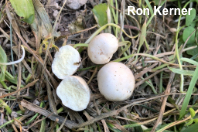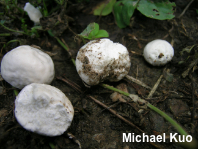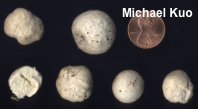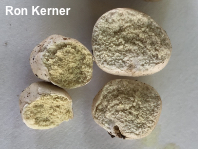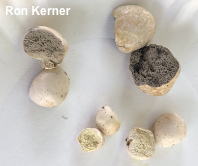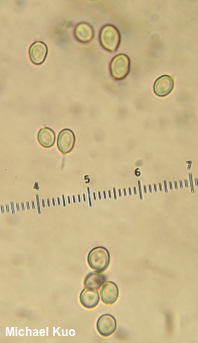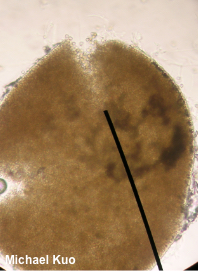| Major Groups > Puffballs > Arachnion album |

|
Arachnion album [ Basidiomycota > Agaricales > Agaricaceae > Arachnion . . . ] by Michael Kuo A lot of small, drab puffballs look like Arachnion album and, as Alexander Smith (1951) wrote, "the average collector is likely to pass it by unless [s]he is making a special search for it." My friend Ron Kerner, however, is no average collector; he noticed the interesting features that separate Arachnion album from the masses—an interior that becomes gray and is composed of tiny, sand-grain-like particles—and sent me his collection to study. This prompted me to go through my 30 or so unidentified puffball collections (they just pile up and I never seem to get to them; would you believe there are more than 110 russulas awaiting lab work?) and, lo and behold, there was a 13-year-old collection of Arachnion album still waiting for me to study and identify it. The little sand-grain-ish particles in the interior of Arachnion album are called peridioles (the same term used to describe the "eggs" in bird's nest fungi) because they are tiny packets in which spores are produced. Under the microscope, this makes Arachnion album very distinctive; the peridioles are discreet, often rupturing in a mount. In North America, Arachnion album is relatively common in grassy areas east of the Rocky Mountains—and it is occasionally reported from Oregon. Thanks to Ron Kerner for collecting, documenting, and preserving some the illustrated and described specimens; his collection is deposited in The Herbarium of Michael Kuo. Description: Ecology: Saprobic; terrestrial; growing gregariously in or near grassy areas (lawns, pastures, ditches, golf courses, and so on); summer and fall; widely distributed and fairly common east of the Rocky Mountains; rarely reported from Oregon. The illustrated and described collections are from Illinois and Indiana. Fruiting Body: Shaped like a ball, or nearly so; 1–2.5 cm across; 1–2.5 cm high; whitish to very pale brownish when fresh, becoming brownish with old age; surface bald; skin paper thin; interior composed of tiny sand-like granules—white at first, then yellowish, then light gray and eventually dark gray; sterile base absent. Odor and Taste: Not distinctive. Microscopic Features: Spores 3–5 x 3–4 µm; broadly ellipsoid or occasionally subglobose, with or without a short (1–2 µm) pedicel; smooth; hyaline to greenish-yellowish in KOH. Capillitium and paracapillitium not found. Peridioles 250–500 x 200–300 µm; ellipsoid or subglobose; brownish yellow; filamentous hyaline hyphae 2–8 µm wide present on the surfaces. REFERENCES: Schweinitz, 1822. (Saccardo, 1888; Coker & Couch, 1928; Lander, 1934; Smith, 1951; Miller & Miller, 1988; Lincoff, 1992; Trierveiler-Pereira, Kreisel & Baseia, 2010; Miller, Grand & Tredway, 2011.) Herb. Kuo 08160503, 06291801. This website contains no information about the edibility or toxicity of mushrooms. |
© MushroomExpert.Com |
|
Cite this page as: Kuo, M. (2018, August). Arachnion album. Retrieved from the MushroomExpert.Com Web site: http://www.mushroomexpert.com/arachnion_album.html |
